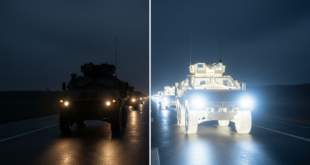In July 2019 US Navy ship in the Persian Gulf reportedly used a new, anti-drone system to take down an Iranian drone that came within a thousand yards, according to Military.com. In a statement, the Department of Defense confirmed that the USS Boxer was moving through the Strait of Hormuz when it was approached by a fixed-wing drone which “closed within a threatening range,” which prompted the ship’s crew to take “defensive action.” Iran has denied the allegation.
According to C4ISRNET, the Marines aboard the USS Boxer used a new system called a MRZR LMADIS — a Light Marine Air Defense Integrated System. The system is mounted on a Polaris MRZR vehicle, which has appeared in DoD photos of the ship. USNI News says that it’s the “first known kill by a new generation of electronic warfare and directed energy weapons” by the US.
The incident is just 28 days after Iran shot down a Global Hawk over the Strait of Hormuz. In a statement after bringing down the US drone on June 20, the IRGC said the pilotless plane had switched off all of its communication systems after take-off and flew towards the port city of Chabahar via the Strait of Hormuz in maximum stealth. The costly military plane was shot down by the IRGC when it violated the Iranian airspace near the Strait of Hormuz and began to spy on Iran and collect information during return to the Emirati airbase, the Iranians say.
The IRGC commander said that the successful destruction of a stealth American spy drone changed the equation in favor of Iran and humiliated the US. “The IRGC Ground Force’s drone and missile power has grown considerably compared to the past, and this will boost our power in battles,” General Pakpour went on to say.
In comments on Tuesday, Brigadier General Mohammad Pakpour said the IRGC Ground Force has devised and exercised new strategies for assault on the enemy. The “deep-attack doctrine” has been put on the agenda of the IRGC Ground Force and was even practiced during the “Payambar-e Azam 12 (The Great Prophet)” wargame held on the southern coasts of Iran in December 2018, the commander said. He added that the IRGC Ground Force will strengthen the necessary training programs and equipment on the basis of the new doctrine.
Iran is in full control of the Persian Gulf and the Strait of Hormuz, a top Iranian Navy commander said earlier. “The naval forces of the Army are prepared to defend the waters with their intelligence dominance and monitoring of the enemy’s physical presence,” Gen. Alireza Tangsiri, chief of the Islamic Revolutionary Guard Corps, said. “We have a message to our Muslim neighbors: We have repeatedly stated that we are extending our hand of brotherhood to you and believe that the Persian Gulf is our home for which we can provide security. There is no need for foreigners such as the United States and the countries whose home is not here.”
IRGC Commander Maj. Gen. Mohammed Ali Jafari reinforced Tangsiri’s comments. “The capabilities of this force [the Iranian navy], in terms of technology, tactics and strategies, are up-to-date and geared to the advancement of technologies at the highest level,” Jafari said. “It is natural that the enemy strictly avoids any conflict because it knows that it would end to its detriment.”
The incident marked the first direct Iranian-claimed attack on US assets and came amid heightened tensions, unleashed by US President Donald Trump’s decision last year to withdraw from the JCPOA, an international accord that curbed Tehran’s nuclear programme. Fears of war between the United States and Iran have intensified after these incidents.
The U.S. Navy’s Fifth Fleet is based in the region and protects shipping lanes in the Gulf and nearby waters. The U.S. Navy’s 5th Fleet is deployed in the Persian Gulf, with aircraft carriers, ships and aircraft. The United States also has military personnel stationed in Saudi Arabia, Kuwait, Bahrain and Turkey. Since the conflict during the Iran-Iraq War, known as the Tanker War, the United States has deterred anti-ship mines, missile fires, swarm attacks, and general harassment from Iran.
US Iran
U.S. President Donald Trump pulled out of an international agreement on Iran’s nuclear programme in May and reimposed sanctions on Tehran. He said the deal was flawed because it did not include curbs on Iran’s development of ballistic missiles or its support for proxies in Syria, Yemen, Lebanon and Iraq. President Donald Trump signed an executive memorandum on Aug 6 2018, kicking off the process for the U.S. to withdraw from the Iran nuclear deal. The deal between Iran and a handful of world powers, brokered in 2015 during the Obama administration, lifted a bevy of sanctions and embargoes on Iran in exchange for the country significantly shrinking the scope of its nuclear capabilities. Iran also gave international inspectors access to its facilities as part of the deal.It prompted a suggestion by Iranian President Hassan Rouhani that Iran could close the Strait of Hormuz.
Tensions between the two countries have increased since the United States withdrew from a 2015 nuclear deal between Iran and Western powers. Tehran has suggested it could take military action in the Persian Gulf to retaliate for U.S. sanctions preventing the transport of Iranian oil, including blockades against countries delivering oil through the Gulf. Last month, Ayatollah Ali Khomenei, Iran’s senior leader, said he supports a policy by which no country can export oil through the Gulf if Iran cannot. Tangsiri’s comments were meant for Iran’s neighbors, as well as the United States, the Iranian government-aligned Press TV said.
Iran’s growing Naval Capability
Islamic Republic of Iran is building up its naval forces to control the Strait of Hormuz owing to its importance as a strategic global chokepoint. Millions of barrels of oil are transported daily to Europe, the United States and Asia through the Bab el-Mandab and the Strait of Hormuz, waterways that run along the coasts of Yemen and Iran.
Iran’s navy in Dec 2018 launched a domestically made destroyer, which state media said has radar-evading stealth properties, as tensions rise with arch-enemy, the United States. In a ceremony carried live on state television, the Sahand destroyer — which can sustain voyages lasting five months without resupply — joined Iran’s regular navy at a base in Bandar Abbas on the Gulf. The Sahand has a flight deck for helicopters, torpedo launchers, anti-aircraft and anti-ship guns, surface-to-surface and surface-to-air missiles and electronic warfare capabilities, state television reported.
An ONI report said last year that Iran’s Guards’ naval doctrine was “based on speed, numbers, stealth, survivability, and lethality” and that it had acquired fast attack craft, small boats, anti-ship cruise missiles and mines. “Individually, these improvements cannot compete with Western technology. However, taken together, they could create an overall capability that is greater than the sum of its parts, particularly when employed in tight operational spaces like the Persian Gulf and Strait of Hormuz,” the ONI said.
President Hassan Rouhani ordered Iran’s Atomic Energy Organization to develop nuclear propulsion for warships. Rouhani has stated that the Joint Comprehensive Plan for Action, an agreement between Iran and the West that ends Iran’s nuclear weapons research, does not block the construction of nuclear-powered warships.
Iran’s navy has extended its reach in recent years, launching vessels in the Indian Ocean and the Gulf of Aden to protect Iranian ships from Somali pirates operating in the area. General Mohammad Hossein Baqeri, chief of staff of the Iranian armed forces said in remarks published on 27 November 2016 that Iran needed a fleet in the Indian Ocean that would be equal to the one stationed in the Gulf of Oman, and urged the Navy to enhance its intelligence activities by working on satellite and cyber-space technologies, as well as by developing naval drones. Iran should also develop its own naval infrastructure, as its coasts could provide space for several new ports, the major general said, stressing that the Islamic Republic should break Russia’s monopoly on providing Central Asian countries with access to international waters.
Taking lessons from Iran-Iraq conflict and subsequent regional wars such as Operation DESERT STORM, Operation ENDURING FREEDOM, and Operation IRAQI FREEDOM , IRGC has decided that its naval strategy would involve fighting an asymmetric war against potential enemies. According to the IRGC commander, an asymmetric war would involve “working on all the weaknesses of the enemy and the maximal usage of our capability.” By choosing an asymmetric approach, however, Iran was not abandoning modern military technology. The IRGC claims that Iran would use its growing arsenal of modern weapons, including cruise missiles, modern mines, and submarines, but in a different way and at a time and place the enemy would not know or expect.
Iran has developed a large domestic arms industry in the face of international sanctions and embargoes that have barred it from importing many weapons. Iran has successfully tested the country’s indigenous Valfajr torpedo system during two week-long naval drills, during which the Islamic Republic also featured other advanced military technology including cruise and anti-ship missiles. The Iranian Navy’s Qadir-class submarines (which are equipped with sonar-evading technology and can fire missiles and torpedoes simultaneously) searched and traced hypothetical enemies’ targets using advanced radar systems and then destroyed them by firing Valfajr torpedoes,” Iran’s Fars news reported.
“What makes Valfajr torpedo stand apart from other similar products in the world is the short preparation time in the supporting and firing units; a characteristic which leads to a remarkable increase in tactical capability and a quick response from surface and subsurface combat units,” Iran’s Defense Minister Brigadier General Hossein Dehghan was quoted as saying earlier.
Also, the Navy’s anti-submarine helicopters used tracking systems to detect subsurface targets in the drill zone and blew them up with their optimized torpedoes. The Iranian naval forces conducted a mine clearance operation during the massive ‘Velayat 95’ wargames in Feb 2017, using sonic and magnetic demining devices.
Mine sweeping and defusing by means of sonic and magnetic equipment and devices requires complicated technology that was just mastered and owned by the big powers, but the Iranian military joined the club in practice today. The Iranian Navy fired the latest version of its home-made coast-to-sea cruise missile, ‘Nasir’, on the second day of the main phase of the massive wargames. Iranian Defense Minister Brigadier General Hossein Dehqan told FNA that the cruise missile has hit the specified target with maximum precision.
Iran is developing a submarine that could launch an anti-ship cruise missile designed to quickly sink an American warship operating in the Strait of Hormuz, according to a new assessment of Iranian naval capabilities published by the U.S. Office of Naval Intelligence. Citing Iranian press reports, the new ONI study – Iranian Naval Forces: A Tale of Two Navies – said development of Tehran’s new Besat-class of diesel-electric attack submarine will include an anti-ship cruise missile (ASCM) capability.
The tensions between Iran and the West, is leading to naval confrontations and threat to merchant shipping Strait of Hormuz will continue to serve as a chokepoint of economic importance for global oil markets and the West.
The U.S. has said it would use minesweepers, warship escorts and potentially air strikes to protect the free flow of commerce but reopening the Strait could be a lengthy process especially if the Guards laid mines. Michael Connell, head of the Iran program with U.S. non-profit research body CNA, said of all Iran’s capabilities, mines were probably the one that caused the most concern. He also said a misjudged incident which would trigger direct fire was a more likely scenario than a blockade of the Strait.
 International Defense Security & Technology Your trusted Source for News, Research and Analysis
International Defense Security & Technology Your trusted Source for News, Research and Analysis



